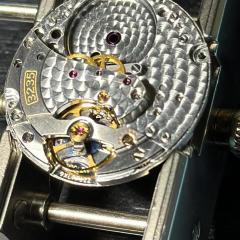-
Similar Content
-
Recently Browsing
- No registered users viewing this page.
-
Topics
-
Posts
-
After another long hiatus (while waiting for truing calipers to arrive), I’ve made some more progress. TRUING IN THE FLAT I was able to use the calipers I purchased to true the wheel in the flat. There’s still a very slight eccentricity in the round, but I’m going to leave it as is. It doesn’t wobble any more and I’m happy with that. Thanks for the tool recommendation @mbwatch. It worked well, though I must say it takes a delicate touch to get the balance between the calipers. Also, my calipers effectively have four different variations based on the orientation of the arms (2 sides, 2 orientations each). Some are more tapered than others, though to what end, I can’t quite tell. My first thought was that flipping them over yields arms that can be used for poising. They are K&D horizontal calipers, btw. OSCILLATION TEST @nevenbekriev @JohnR725 After truing the wheel in the flat, I carefully remounted the hairspring and did your oscillation test. Balance wheel mounted to balance cock, no pallet fork, rotate balance wheel 180 degrees, let it go, and time+count the oscillations. Results as follows for dial down orientation: Duration: 1m 15sec (to full stop) # of oscillations: About 125, though the amplitude of the oscillations decreased significantly, as one might expect I should redo the test in at least two other orientations…Forgot to do that. 🙂 In general, it’s safe to say this watch has a pretty low amplitude, likely for a variety of reasons. I haven’t oiled the balance jewels FWIW…I should probably do that, but I really don’t want to keep disassembling and reassembling the balance. Is it possible to oil those jewels (top and bottom) by just removing the capstones and putting in a tiny amount of oil, with balance in place? I can see how having the pivot in the jewel hole could change how capillary action works, and thus might pull more oil in than desired. However, those capillary forces will be in effect anyway once the balance is inserted. PRACTICE MOVEMENTS @JohnR725 I agree with your sentiment about using practice movements wholeheartedly, and I’ve done that to some degree. The watch I’m currently repairing is for a friend, and she was willing to have me treat it as a “learn-by-doing experience.” With that said,, I probably should have purchased a few more “beaters” before getting to something where I don’t want to muck things up. I’ve still got a couple of those on the bench that I used as donors, and I’ll try to rehabilitate them.
-
Hi, this is the first place I found when looking for advice so I hope someone could advise me. Im completely new to touching watches but I’ve always wondered how they work. I’ve bought a cheap movement, an ETA replica to take apart and rebuild. Im thinking I’ll need some screwdrivers, tweezers, movement holder and a loop? My goal is just to have a go first and see if I enjoy it enough before buying more tools. Do I buy cheap tools for now and get better quality tools later if I enjoy it like I think I will? or will the cheap tools be a pain and take some of the fun out of it? With quality tools being relatively expensive I’m unsure what to buy. Any advice would be greatly appreciated!
-
Yeah I have seen 44-56 documented for Elgin 18 size elsewhere. I have the style of gauge that's like a set of feeler gauges and I never noticed before today it is faintly stamped "Elgin". Pictured is the way I have been measuring. I am going to go to a larger jewel than the 42 that had been in there. I recently won an auction on a big set of Fitrite jewels all in the little bottles, to discover that the what's actually in the bottles bears no relation to the chart of sizes printed on the box. In most cases it seems to be all mixed so in fact I have about 24 little bottles and thousands of assorted jewels of all diameters and lengths, which is better than nothing. But since I don't have a micrometer with a table, measuring for the exact diameter will be a big job. Instead I will test a lot of them in the fork slot the same way I measure with the gauge. But this is still the next thing. I have to get the escapement to unlock first.
-
it would be nice to have the exact model of the watch the or a picture so we can see exactly what you're talking about. this is because the definition of Swiss watch could be a variety of things and it be helpful if we could see exactly the watch your dealing with then in professional watch repair at least some professionals they do pre-cleaned watches. In other words the hands and dial come off and the entire movement assembled goes through a cleaning machine sometimes I think a shorter bath perhaps so everything is nice and clean for disassembly makes it easier to look for problems. Then other professionals don't like pre-cleaning because it basically obliterates the scene of the crime. Especially when dealing with vintage watches where you're looking for metal filings and problems that may visually go away with cleaning. Then usually super sticky lubrication isn't really a problem for disassembly and typically shouldn't be a problem on a pallet fork bridge because there shouldn't be any lubrication on the bridge at all as you typically do not oil the pallet fork pivots.
-
By Neverenoughwatches · Posted
A few things you should find out before you can mske a decision of what to do. As Richard said, what is the crown and all of the crown components made of . Then also the stem . The crown looks to have a steel washer that retains a gasket. So be careful with what chemicals you use to dissolve any stem adhesives or the use of heat. You might swell or melt the gasket unless you are prepared to change that also . The steel washer maybe reactive to alum. Something I've just used to dissolve a broken screw from a plate. First drilled out the centre of the screw with a 0.5mm carbide . Dipped only the section that held the broken screw in Rustins rust remover. This is 40 % phosphoric acid. 3 days and the screw remains were completely dissolved, no trace of steel in the brass threads. A black puddle left in the solution.
-









Recommended Posts